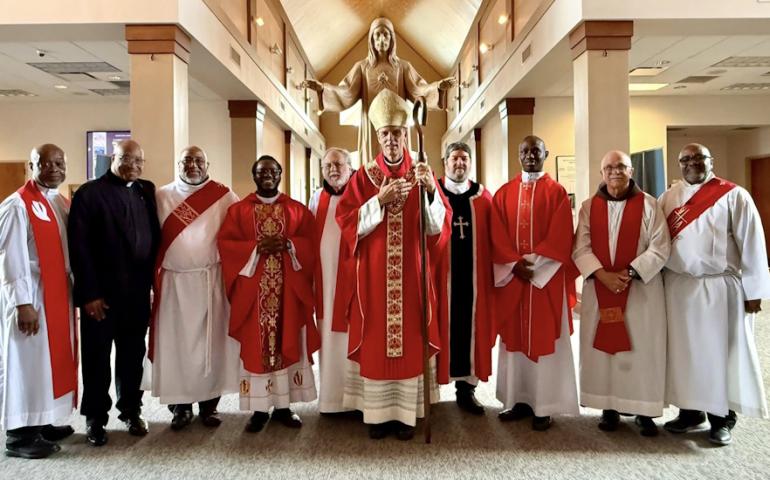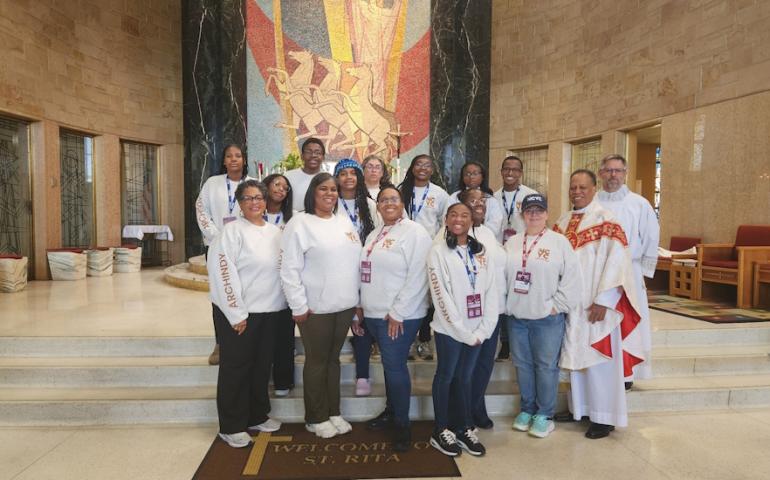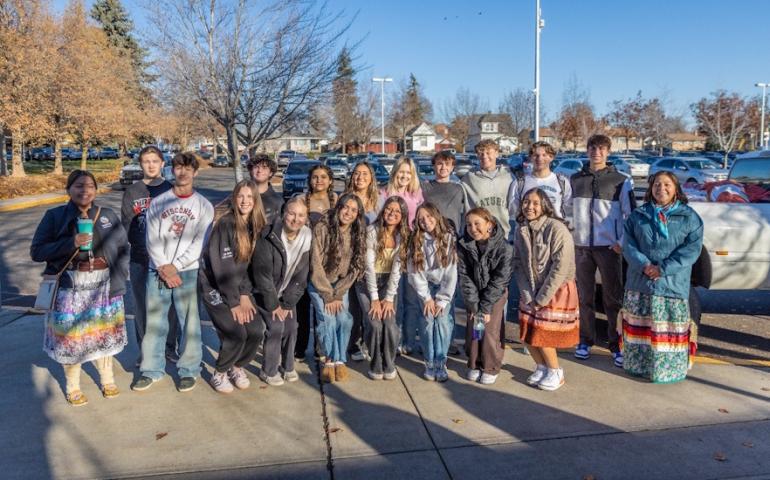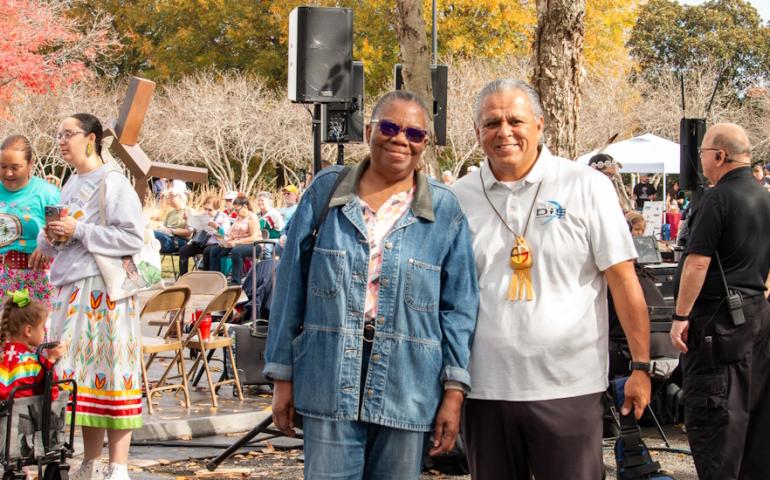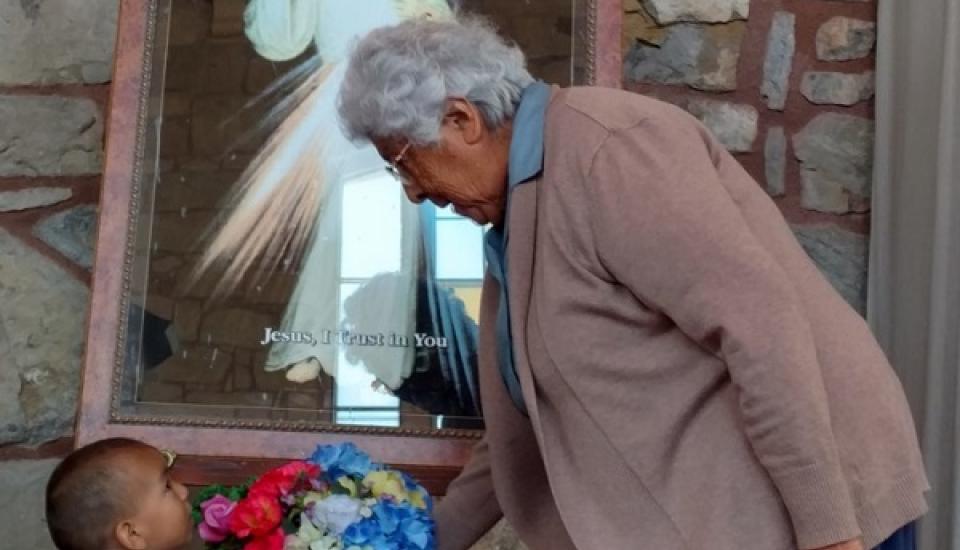
St. Joseph Apache Mission
Throughout my life I have heard the expression that angels and saints come in many shapes, sizes and colors. I know this to be true, and Sr. Juanita Little, OSF is an angel and saint, although she would tell you different. But whatever title you give her, she is very special indeed. Her favorite title is grandma, and that she is to hundreds.
By the time I first met Sr. Juanita in 1974 she had been in the religious order of the Franciscan Sisters of Our Lady of Perpetual Help out of St. Louis, MO for almost 20 years. I meet her in her homeland, the Mescalero Apache Reservation and felt welcomed and accepted by her whole family.
Sr. Juanita is of multi-cultural Spanish, Tewa, Mexican and Mescalero Apache ancestry. Being raised in a Native American Catholic family meant trying to find common ground between the two traditions. This helped mold her into the person that she is today; a strong, open-minded, compassionate woman of faith that is comfortable being among any group of people.
From the very beginning of her ministry she felt that she would one day work in her Mescalero community. She was assigned to teach in Tularosa, Gallup and Alamogordo, NM. While in the area she made time to go to Mescalero to teach catechism and prepare the children to receive the sacraments. After being in New Mexico a few years she was sent to Illinois and Nebraska before being assigned to the Fr. James B Hayes Catholic School in Alamogordo. She spent her mornings teaching kindergarten and her afternoons in Mescalero teaching catechesis.
By the time I moved to the area in 1978 she was introduced to the National Tekawitha Conference where she met other Native American religious. These women shared that their communities did not allow them to work among their tribes. Many also were not allowed to participate in their traditional ceremonies. She felt blessed that her order never put such stipulations on her. She said “To be a Catholic meant denying a part of yourself, which we felt was not right.”
That first meeting united those Native Americans within the Catholic Church to organize and start in motion a plan to be heard by the greater Church. Their main goal was to teach church leaders that “They couldn’t just leave their heritage at the door – they needed to be accepted by and into the Church with their full identity.”
The Bishops agreed and asked the group to write a catechism for Native Americans in their language. The problem was evident; there were way too many languages to make this possible. The decision was made instead to incorporate traditional ways of prayer into their parishes. Our parish, St. Joseph Apache Mission had been blessed with a Franciscan Pastor, Fr. Albert Braun in 1916 who had seen the importance of keeping the Mescalero traditions alive in the parish. To this day we have Native vessels, songs and blessings in the confines of our Masses. If you visit the church you will be surrounded by Native American works of art.
By 1980 Sr. Juanita began working full time here at the Mission. She started a prayer circle to pray for the intersession of Kateri Tekawitha to send someone to maintain and repair the much neglected massive stone church. In 1985 she was joined by Sr. Robert-Ann Hecker, OSF and by 1990 they both were fully engrossed in every kind of work in the parish.
Finally, Sister’s prayers were answered, but little did she know that God would send three small in stature Franciscan Friars from the St. Barbara Province in California. One was an engineer full of energy and ready to jump in. Brother Peter Boegel, OFM did what he could and soon found out that the largest obstacle was funding. So a group was formed, and fundraising began.
By the late 1990s the Diocese of Las Cruces considered condemning St. Joseph Apache Mission church because of its deteriorated condition, and because the cost of correcting the problem seemed beyond the means of the diocese. With the first $24,262 raised, a local Contractor began a test panel of stone repointing and estimated the cost of repairing the entire building at $1.5 million.
The estimate was not an amount that the parish could raise quickly, so their leaders dispatched Brother Peter and local parishioner Harry Vasile for training in historic stone preservation. The plan was to have these two men perform the restoration work while an ongoing search for funds continued. One goal of this strategy was to keep the Mission open to the visiting public and for services during the restoration. Full-time work began in February 2000 and lasted until 2015 with a total cost of $2.5 million spent.
By the end of the 1990s, Sister moved into her parent’s home to help care for them, but soon she felt called to help in her community at large. So for the next 12 years she worked to bring awareness to the country, state and tribal leaders for the need for laws to protect women and children of abuse. Restraining orders were finally made available. She continued to work at the Mescalero Courts as an advocate for victims of violence for three more years.
With another goal conquered, she next was asked to go to the school to be their liaison with the parents and students. She did home visits to assess the needs and counseled both parents and students.
She officially retired in 2008, but continues to volunteer at the church — teaching confirmation and baptismal preparation, ministering to the sick, cleaning the church — whatever is needed. To this day, she continues to try to be that presence to the people of the Mescalero Apache Reservation.





